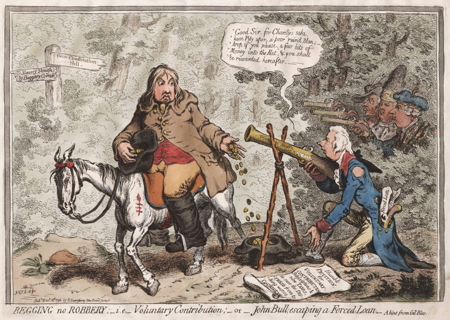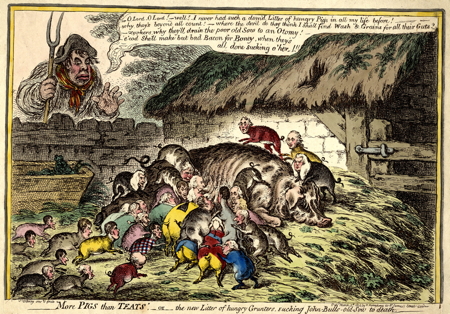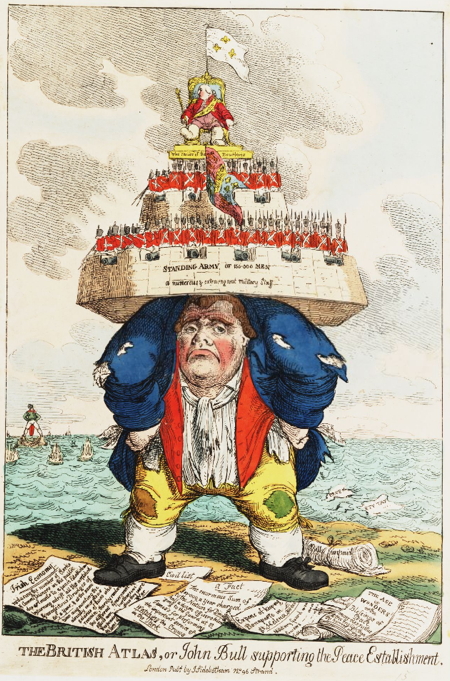James Gillray (1756-1815) trained as an engraver but became best known for making hundreds of caricatures of British social and political life in the 1790s and 1800s. He satirized in particular King George III, William Pitt, the French Jacobins, Napoleon, and many others in the British political and military establishment. A recurring theme in his work was the dramatic increase in taxation and the national debt which was imposed in order to fight the wars against Napoleon and which placed a growing burden on the English people (represented as “John Bull”).
Gillray also satirized the large numbers of well-connected people in the government and the military who profited from increased government expenditure by depicting them as greedy cormorants, sucking pigs, highway men, and wasps and hornets. These individuals came from both sides of the political spectrum (from the both the Whig and the Tory parties) and were thus called members of the “Broad Bottom’d” (or bipartisan) party.

“BEGGING no ROBBERY; i.e. Voluntary Contribution; or John Bull escaping a Forced Loan” (1796) s one of several caricatures Gillray did about the “voluntary loan” which was a thinly veiled threat by the government that a “forced loan” would be imposed on taxpayers to raise money for the war effort if they did not make “voluntary” contributions to the exchequer.
Here we see John Bull riding an emaciated horse which looks like it is on its last legs. He has been waylaid by highwaymen hiding in the bushes as he rides by and is obliged to make a “donation” of coins into their hat instead of being forced to make a loan to the government to fund the army. The men in the bushes on the right have pistols pointed at him and are wearing fine robes and hats which suggest that they represent the aristocracy, the church, and the law. The man kneeling by the roadside is a soldier wearing torn and bedraggled clothes. He has in his pocket a pistol and a sheet of paper which says “forced loan in reserve”. He is holding a blunderbuss on which is written “standing army”. In the speech bubble above him it says “Good Sir, for Charity’s sake, have Pity upon a poor ruin’d Man; drop if you please, a few bits of Money into the Hat, & you shall be rewarded hereafter.”

“More PIGS than TEATS, or the new Litter of hungry Grunters sucking John Bull’s old Sow to death” (1806). In this caricature John Bull is shown as a pig farmer who has come to check on his old sow in the pig stye. The sow represents the British economy which was being sucked dry by all the demands being placed upon it by the British government in order to fight the war against Napoleon, especially the new war taxes. Those doing the “sucking” are the vested interests which benefited from the policy of war, such as members of the government, the law, the military, and the aristocracy. John Bull is shocked to see his poor emaciated sow (emaciated and near death, with a very forlorn look on her face) being besieged by “hungry Grunters” wanting to suck at her teats. John Bull says “O Lord. O Lord! I never had such a dam’d Litter of hungry pigs in all my life before! why they’s beyond all count! [I count 28 (editor)]. where the devil do they think I shall find Wash & Grains for all their Guts? zookers, why they’ll drain the poor old Sow to an Otomy! (?) e’cod She’ll make but bad Bacon for Boney [the English nickname for Napoleon Bonaparte], when they’s all done sucking o’her!!!”

“A Great Stream from a Petty-Fountain; or John Bull swamped in the Flood of new-Taxes; Cormorants Fishing the Stream” (1806). In this caricature, on the left we see John Bull (the personification of Britain) in a sinking boat which has been swamped by a mass of new taxes to fund the war against Napoleon. He has lost hold of an oar with the name of “William Pitt” written on it. [William Pitt the Younger was Prime Minister from 1804-1806 as well as Chancellor of the Exchequer (or minister of finance)]. On the right we see a man’s head (probably Lord Henry Petty the new Chancellor of the Exchequer) from whose mouth pours a fountain of water labeled “new taxes” which are named in the cascades of the fountain (taxes on salt, tea, hops, malt, sugar, alcohol, candles, horses, servants, soap, houses, land, stamps, windows, property, etc.). In the foreground we see 10 hungry cormorants with human heads devouring the fish, crabs, and eels which thrive in the waters of the tax fountain. In the middle ground there are 2 other human-headed birds; in the distance we can see dozens more hungry cormorants heading towards the tax feast. The heads of the cormorants probably depict prominent politicians and other figures of the day.
In these cartoons Gillray seems to have an understanding of a classical liberal theory class analysis where the productive many are exploited by the unproductive few. This view is epitomised in this 1816 illustration of John Bull as a modern “Atlas” who has to carry the parasitic British establishment of the monarchy and the standing army on his shoulders.

For a discussion of more images by Gillray, see this illustrated essay and “John Bull as the British Atlas” (1816).
See also “Images of the Ruling Class and the State” and “Images of the Ruled as “Atlas”
